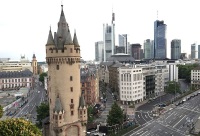
The Eschenheimer Turm is one of the few remaining towers of the medieval fortifications that once encircled the city of Frankfurt. The 154-foot high (47m) Gothic tower was built as part of the medieval wall which encircled the city in the 15th century, when approximately 60 towers surrounded the city. Citizens used to build high walls and watchtowers to protect Frankfurt from danger. The tower is both the oldest and the most unaltered building in the largely reconstructed city centre of Frankfurt and it is a striking landmark of the city. The tower has eight levels and four smaller side-turrets and looks rather like something out of a fairy-tale.There is a weather vane perched on the very top which is the subject of a local myth: apparently a convicted poacher shot the vane nine times and so impressed the city authorities that they set him free. You can clearly see nine bullet holes if you get close enough to the vane, but it is definitely not still the same one from the story. Now a popular tourist attraction in Frankfurt, there is a restaurant and bar at the base of the Eschenheimer Turm that offers a good place to people-watch in the busy plaza surrounding the tower.
Address : Eschenheimer Tor 1
The well-ordered and interesting Botanical Garden in Frankfurt is administered by the university and is really a beautiful place to spend a few hours. The gardens are designed to take visitors on a journey through different areas of the plant kingdom, from the hardwood forests of North America to the barren savannah of Africa. The gardens cover more than eight hectares (20 acres) and contain more than 6,000 different botanical species, from exotic rainforest flowers to European weeds. There are many enclosed greenhouses so there is still lots to see in winter. Aside from admiring the flora, there are fun family activities like miniature golf and boat hire to enjoy, as well as a gift shop and cafe. The botanical garden is a great attraction for the whole family and if you're travelling with kids in Frankfurt its a nice break from more traditional sightseeing. There is a playground in the gardens to amuse little ones.
Address : Siesmayerstrasse 61
Website : www.botanischergarten-frankfurt.de
Telephone : (0)69 2123 3939
Transport : Entrance Palmengartenstraße: trains U6, U7 or buses 32, 33, 50 to Station Bockenheimer Warte
Opening times : 9am to 6pm Monday to Saturday, 9am to 1pm Sundays and holidays, between February and October. Hours are reduced in winter.
Admission : Admission is free.

The Frankfurt Zoo, located in Ostend, was almost completely destroyed in World War II, with only 20 animals surviving. It was rebuilt in the early 1950s and since then has grown to include several innovative new sections such as the highly popular Big Cat Jungle, and the Exotarium which houses fish, insects, reptiles and penguins, all kept in their natural surroundings. The Frankfurt Zoo is home to more than 3,200 animals, from about 600 species, and is renowned for keeping them in environments that closely resemble their own natural habitats. A major draw card for the zoo and one of its most unique features is Grzimek House which is home to nocturnal animals who think it's night-time during the day. Other popular animals include the tigers, rhinos, lions, crocodiles and hippos, among many others. The zoo has a reputation for being one of the most attractive, pleasant and popular zoos in Europe. Away from the fauna there are two restaurants as well as a terrace to enjoy in the summer months.
Address : Alfred-Brehm-Platz 16
Website : www.zoo-frankfurt.de
Transport : U6 or U7
Opening times : Open daily 9am to 7pm in summer, and 9am to 5pm in winter.
Admission : €10 (adults), €5 (children 6-17). Concessions available.
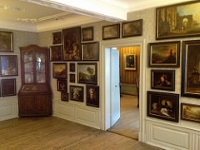
The house where Johan Wolfgang von Goethe, Germany's world-famous poet and writer, was born in 1749 is now a shrine to his memory, preserved as an example of how the well-to-do lived in Frankfurt in the late Baroque era. The house, which is a reconstruction because the original was destroyed during the Second World War, consists of two neighbouring half-timbered houses in Grosser Hirschgraben, and is situated next to the Goethe Museum, which contains a huge library of books, documents and graphics relating to the poet. Although the appeal of Goethe-Haus is self-evident for those that love his work, even if you are not particularly interested in Goethe this attraction provides welcome insight into 18th-century Frankfurt. All the rooms are beautifully decorated and furnished and many of the objects have recorded stories and associations from the Goethe family. Unfortunately, there is no wheelchair or baby carriage access to the house.
Address : Großer Hirschgraben 23-25
Website : www.goethehaus-frankfurt.de
Telephone : (0)69 138 80-0
Transport : U- and S-Bahn to Hauptwache and Willy-Brandt-Platz
Opening times : House and Museum open daily, Monday to Saturday 10am to 6pm, Sunday and public holidays 10am to 5.30pm. Library open Monday to Friday 10am to 12pm and 1pm to 4pm.
Admission : €7 (regular); €3 (reduced); free for children under 6.
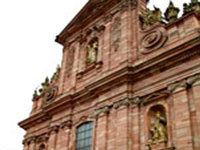
The historic university town of Heidelberg, about 55 miles (89km) south of Frankfurt, is billed as a city of music and romance. It is one of the few German cities that escaped relatively unscathed from air raids during World War II, and still has numerous buildings from the Middle Ages and Renaissance to explore, including some beautiful historical churches. The university was established in 1386, and features some picturesque buildings on its campuses. A good way to enjoy scenic views of Heidelberg is along the Philosopher's Walk, a path alongside the Heiligenberg, so named because university professors would walk along the path when they needed to think.The city is built along the banks of the Neckar River, and has a vibrant atmosphere thanks to its large student population, particularly in the student quarter with its narrow streets and lively inns. The modern part of the city, around the Bismarckplatz, has some good hotels and restaurants, and enticing shopping plazas. The weather in Heidelberg is famously sunny and warm compared to much of Germany, and this is a major draw for the millions of tourists who visit each year.
Website : www.heidelberg.de
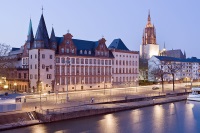
The Historical Museum (Historisches Museum) has many permanent exhibitions featuring objects and works of art ranging from the Middle Ages to the present day. The museum's changing exhibitions cover a range of themes such as cultural history, art history and general history. Collections feature examples of gold and silver crockery and jewellery; pottery and porcelain; paintings and photographs; and scaled-down models of the Altstadt (Frankfurt old town) at various periods of its development. The museum is useful for giving visitors an idea of what Frankfurt looked like before the damage of World War II when it was quite a different city in some regards.The Children's Museum, which lies adjacent to the Historical Museum, features a variety of special offers and exhibitions for youngsters of all ages. The museum has recently undergone extensive renovations and has been greatly improved.
Address : Saalgasse 19
Website : www.historisches-museum.frankfurt.de
Transport : U-bahn to Römer
Opening times : Tuesday to Sunday 10am to 5pm, Wednesday 10am to 9pm, closed Mondays.
Admission : €7 (adults), €3.50 (reduced).
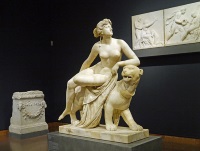
Situated on the south bank of the river Main, the Liebieghaus was built in 1896 for Czech Baron Heinrich Liebieg, but today is the home of Frankfurt's Museum of Sculpture. The building itself is gorgeous and castle-like and adds a great deal to the atmosphere and appeal of this interesting museum. Exhibits include sculptures from ancient times, covering art from Sumeria, Egypt, Greece and Rome as well as more modern Baroque, Rococo and Renaissance examples. A range of Asian pieces also feature in the collection as well as a few works by world-renowned artists. There are about 5,000 pieces in the collection and the museum feels intimate and is usually less crowded than other big art museums in Frankfurt. The Liebieghaus also puts up some great temporary exhibits showcasing modern sculptors - check the website to see what is currently on show. Labels and tours are in multiple languages and there are audio guides available. The cafe outside in the courtyard is charming.
Address : Schaumainkai 71
Website : www.liebieghaus.de
Transport : Tram 15 or 16 to Otto Hahn Square; U1, 2, 3 to Swiss Square
Opening times : Tuesday, Wednesday and Friday to Sunday 10am to 6pm; Thursday 10am to 9pm; closed Mondays.
Admission : €10 (adults); €8 (reduced). Children under 12 are free.
One of the biggest natural history museums in Germany and housed in a building which is a UNESCO World Heritage Site, the Senckenberg Museum of Natural History in Frankfurt features extensive exhibits showcasing biodiversity and the evolution of the planet and of life on earth. A popular attraction of the museum is the fascinating palaeontology exhibit which features fossils that date back over 50 million years; dinosaurs simply never go out of fashion with kids. There is also a huge collection of stuffed animals on display.Children of all ages, and adults, will love exploring this fascinating museum and learning about the solar system and the evolution of life. Some of the labels and descriptions are only in German which is a disadvantage. Despite this, the museum is consistently rated highly as an attraction in Frankfurt by visitors and it is one of the best places to bring kids in the city. There is a nice museum cafe on the top floor where you can get refreshments and light meals.
Address : Senckenberganlage 25
Website : www.senckenberg.de
Telephone : 069 7542 0
Opening times : Monday, Tuesday, Thursday and Friday 9am to 5pm. Wednesday 9am to 8pm. Saturday and Sunday 9am to 6pm. Closed for some public holidays.
Admission : €8 (adults); €6.50 (pensioners); €4 (children and teenagers aged 6 to 15); free for children under 6; concessions available.
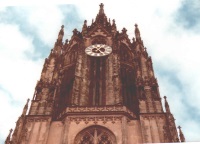
St Bartholomews Cathedral, or Dom Sankt Bartholomäus, dominates the Frankfurt skyline with its imposing 311-foot (95m) spire, contrasting sharply with the modern skyscrapers in the downtown area. The cathedral was built in the 14th and 15th centuries, and has seen the crowning of kings and emperors. St Bartholomews has been rebuilt several times, once in 1867 after a fire, and again in the 1950s following damage suffered in World War II. The architecture is traditional Gothic. The cathedral boasts some artistic treasures and the carvings are particularly striking. You can climb the winding spiral stairs to reach the bells in the tower for some spectacular views. There is a small museum and shop inside. You can get information booklets at the door which are quite informative and tell you a bit about the church's history and the artefacts on display. As the cathedral is still an active place of worship it is partially closed to tourists at times for services.
Address : Domplatz 14
Website : www.dom-frankfurt.de
Telephone : 0 69 29 70 32 0
Transport : U4 from Central-Station, Stop Römer
Opening times : Open Tuesday to Friday 10am to 5pm, and Saturday to Sunday 11am to 5pm. Opening times vary depending on church services.
Admission : Free
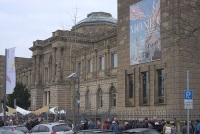
Frankfurt's most important art gallery is the Städel Gallery which contains a fantastic collection of most European schools of painting. The first floor features the works of German painters of the 19th and 20th centuries, as well as famous French Impressionists such as Renoir and Monet. The second floor offers visitors the pleasure of viewing an outstanding collection of Flemish primitives, 17th-century Dutch artists, and 16th-century German masters such as Dürer, Grünewald, Memling, Elsheimer, and many others. One of the most impressive paintings is Jan van Eyck's 'Madonna' (1433). The gallery also puts up regular temporary exhibitions of very high quality and it is worth checking the website to see what's on during your visit. The gallery has a restaurant, a coffee shop and a bookstore which has a selection of great gifts. This gallery is consistently ranked very highly as an attraction in Frankfurt by tourists.
Address : Schaumainkai 63
Website : www.staedelmuseum.de
Telephone : (0)69 605 0980
Transport : U1, 2, 3 to Schweizer Platz; trams 15 and 16 to Otto-Hahn-Platz
Opening times : Tuesday, Wednesday, Saturday, Sunday 10am to 6pm; Thursday, Friday 10am to 9pm; closed Mondays.
Admission : €14 (adults); €12 (reduced); free for children under 12.
The Fairy-Tale Road follows a meandering 370-mile (595km) route that traces the path of famous storytellers the Brothers Grimm. Many people don't realise that the Brothers Grimm didn't simply invent their famous stories, but recorded and collected local legends and folk tales from their homeland near Frankfurt. Between charming villages and well-preserved medieval towns, Germany's Fairy-Tale Road wanders through lush forests and 'gingerbread' houses that inspired the worlds of well-loved characters like Sleeping Beauty, Little Red Riding Hood and Hansel and Gretel.Starting in the town of Hanau, where Jakob and Wilhelm Grimm were born, visitors can explore attractions like the Brothers Grimm monument in the town square, the Puppet Museum at Williamsbad, the Marienkirche where Jakob was married, and the Phillippsruhe Palace, which hosts performances of the fairy-tales (though mostly in German).The next town on the journey is Steinau, where the brothers spent their youth; and Marburg, a university town where they began to research local legends for their collection. Further on the town of Kassel is home to the Brothers Grimm Museum. Nearby Baunatal was the home of Dorothea Viehmann, who told the Brothers Grimm many stories, and visitors can have a beer in the Knallhüt brewery, which occupies the building she was born in.From there the Fairy-Tale Road follows the Weser River to Hameln, the famous town of the Pied Piper. In nearby Bad Oeynhausen travellers will find the Fairy-Tale Museum. The road ends in the town of Bremen, home of both the mythical Little Nienburg Girl and the very real Rathaus, a vibrant marketplace filled with town musicians and the famous Ratskeller Restaurant.
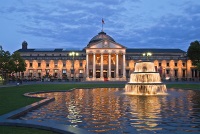
Wiesbaden is arguably Germany's most favoured spa resort and it lies about 25 miles (40km) west of Frankfurt in a valley between the Rhine River and Taunus Mountains. This charming and ancient town makes for the perfect excursion from Frankfurt. The town has been a spa resort since the time of the ancient Romans, with its 26 hot springs averaging temperatures of around 122°F (50°C).Besides being known for its luxurious spa hotels, Wiesbaden is also a cultural centre, its events being concentrated around the major Kurhaus concert hall complex. The complex includes a casino and restaurant, conference and exhibition facilities. There are many quality restaurants in the village and Wilhelmstrasse is a good starting point for explorations of the town because it is the best shopping street and boasts some striking architectural landmarks. A walking tour is a nice way to take in the historical and cultural attractions of Wiesbaden. Another great activity is a visit to the Greek Orthodox Church on the hill which has beautiful views and can be reached by the Nerobergbahn, a water-powered train which has been running since the late 1800s. There are also obstacle courses, a swimming pool and a cafe on the top of the hill.

Travel Guide powered by Word Travels, copyright © 2023 Globe Media Ltd. By its very nature information in this travel guide is subject to change at short notice and travellers are urged to verify information on which they're relying with the relevant authorities. Neither Globe Media Ltd nor Travel Vogue can accept any responsibility for any loss or inconvenience to any person as a result of information contained above.